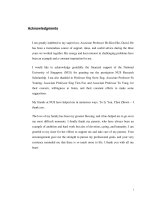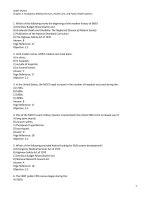Business statistics a decision making approach 6th edition ch07ppln
Bạn đang xem bản rút gọn của tài liệu. Xem và tải ngay bản đầy đủ của tài liệu tại đây (348.8 KB, 51 trang )
Business Statistics:
A Decision-Making Approach
6th Edition
Chapter 7
Estimating Population Values
Business Statistics: A Decision-Making Approach, 6e © 2010 PrenticeHall, Inc.
Chap 7-1
Chapter Goals
After completing this chapter, you should be
able to:
Distinguish between a point estimate and a confidence
interval estimate
Construct and interpret a confidence interval estimate for a
single population mean using both the z and t distributions
Determine the required sample size to estimate a single
population mean within a specified margin of error
Form and interpret a confidence interval estimate for a
single population proportion
Business Statistics: A Decision-Making Approach, 6e © 2010 PrenticeHall, Inc.
Chap 7-2
Confidence Intervals
Content of this chapter
Confidence Intervals for the Population
Mean,
when Population Standard Deviation is Known
when Population Standard Deviation is Unknown
Determining the Required Sample Size
Confidence Intervals for the Population
Proportion, p
Business Statistics: A Decision-Making Approach, 6e © 2010 PrenticeHall, Inc.
Chap 7-3
Point and Interval
Estimates
A point estimate is a single number,
a confidence interval provides additional
information about variability
Lower
Confidence
Limit
Point Estimate
Upper
Confidence
Limit
Width of
confidence interval
Business Statistics: A Decision-Making Approach, 6e © 2010 PrenticeHall, Inc.
Chap 7-4
Point Estimates
We can estimate a
Population Parameter …
with a Sample
Statistic
(a Point Estimate)
Mean
μ
x
Proportion
p
p
Business Statistics: A Decision-Making Approach, 6e © 2010 PrenticeHall, Inc.
Chap 7-5
Confidence Intervals
How much uncertainty is associated with a
point estimate of a population parameter?
An interval estimate provides more
information about a population
characteristic than does a point estimate
Such interval estimates are called
confidence intervals
Business Statistics: A Decision-Making Approach, 6e © 2010 PrenticeHall, Inc.
Chap 7-6
Confidence Interval Estimate
An interval gives a range of values:
Takes into consideration variation in sample
statistics from sample to sample
Based on observation from 1 sample
Gives information about closeness to
unknown population parameters
Stated in terms of level of confidence
Never 100% sure
Business Statistics: A Decision-Making Approach, 6e © 2010 PrenticeHall, Inc.
Chap 7-7
Estimation Process
Random Sample
Population
(mean, μ, is
unknown)
Mean
x = 50
I am 95%
confident that
μ is between
40 & 60.
Sample
Business Statistics: A Decision-Making Approach, 6e © 2010 PrenticeHall, Inc.
Chap 7-8
General Formula
The general formula for all
confidence intervals is:
Point Estimate ± (Critical Value)(Standard Error)
Business Statistics: A Decision-Making Approach, 6e © 2010 PrenticeHall, Inc.
Chap 7-9
Confidence Level
Confidence Level
Confidence in which the interval
will contain the unknown
population parameter
A percentage (less than 100%)
Business Statistics: A Decision-Making Approach, 6e © 2010 PrenticeHall, Inc.
Chap 7-10
Confidence Level, (1-α)
Suppose confidence level = 95%
Also written (1 - α) = .95
A relative frequency interpretation:
(continue
d)
In the long run, 95% of all the confidence intervals
that can be constructed will contain the unknown
true parameter
A specific interval either will contain or will
not contain the true parameter
No probability involved in a specific interval
Business Statistics: A Decision-Making Approach, 6e © 2010 PrenticeHall, Inc.
Chap 7-11
Confidence Intervals
Confidence
Intervals
Population
Mean
σ Known
Population
Proportion
σ Unknown
Business Statistics: A Decision-Making Approach, 6e © 2010 PrenticeHall, Inc.
Chap 7-12
Confidence Interval for μ
(σ Known)
Assumptions
Population standard deviation σ is known
Population is normally distributed
If population is not normal, use large sample
Confidence interval estimate
x ± z α/2
Business Statistics: A Decision-Making Approach, 6e © 2010 PrenticeHall, Inc.
σ
n
Chap 7-13
Finding the Critical Value
Consider a 95% confidence interval: z α/2 = ±1.96
1 − α = .95
α
= .025
2
z units:
x units:
α
= .025
2
z.025= -1.96
Lower
Confidence
Limit
0
Point Estimate
Business Statistics: A Decision-Making Approach, 6e © 2010 PrenticeHall, Inc.
z.025= 1.96
Upper
Confidence
Limit
Chap 7-14
Common Levels of
Confidence
Commonly used confidence levels are
90%, 95%, and 99%
Confidence
Level
80%
90%
95%
98%
99%
99.8%
99.9%
Confidence
Coefficient,
z value,
1− α
z α/2
.80
.90
.95
.98
.99
.998
.999
1.28
1.645
1.96
2.33
2.57
3.08
3.27
Business Statistics: A Decision-Making Approach, 6e © 2010 PrenticeHall, Inc.
Chap 7-15
Interval and Level of
Confidence
Sampling Distribution of the Mean
α/2
Intervals
extend
fromσ
x + z α/2
to
x − z α/2
1− α
α/2
x
μx = μ
x1
x2
n
σ
n
Confidence Intervals
Business Statistics: A Decision-Making Approach, 6e © 2010 PrenticeHall, Inc.
100(1-α)%
of intervals
constructed
contain μ;
100α% do
not.
Chap 7-16
Margin of Error
Margin of Error (e): the amount added and
subtracted to the point estimate to form the
confidence interval
Example: Margin of error for estimating μ, σ known:
x ± z α/2
σ
n
Business Statistics: A Decision-Making Approach, 6e © 2010 PrenticeHall, Inc.
e = z α/2
σ
n
Chap 7-17
Factors Affecting Margin of
Error
e = z α/2
σ
n
Data variation, σ :
e
as σ
Sample size, n :
e
as n
Level of confidence, 1 - α :
e
if 1 - α
Business Statistics: A Decision-Making Approach, 6e © 2010 PrenticeHall, Inc.
Chap 7-18
Example
A sample of 11 circuits from a large normal
population has a mean resistance of 2.20
ohms. We know from past testing that the
population standard deviation is .35 ohms.
Determine a 95% confidence interval for
the true mean resistance of the
population.
Business Statistics: A Decision-Making Approach, 6e © 2010 PrenticeHall, Inc.
Chap 7-19
Example
(continue
d)
A sample of 11 circuits from a large normal
population has a mean resistance of 2.20
ohms. We know from past testing that the
population standard deviation is .35 ohms.
Solution:
x ± z α/2
σ
n
= 2.20 ± 1.96 (.35/ 11 )
= 2.20 ± .2068
1.9932 .......... ..... 2.4068
Business Statistics: A Decision-Making Approach, 6e © 2010 PrenticeHall, Inc.
Chap 7-20
Interpretation
We are 98% confident that the true mean
resistance is between 1.9932 and 2.4068 ohms
Although the true mean may or may not be in
this interval, 98% of intervals formed in this
manner will contain the true mean
An incorrect interpretation is that there is 98% probability that this
interval contains the true population mean.
(This interval either does or does not contain the true mean, there is
no probability for a single interval)
Business Statistics: A Decision-Making Approach, 6e © 2010 PrenticeHall, Inc.
Chap 7-21
Confidence Intervals
Confidence
Intervals
Population
Mean
σ Known
Population
Proportion
σ Unknown
Business Statistics: A Decision-Making Approach, 6e © 2010 PrenticeHall, Inc.
Chap 7-22
Confidence Interval for μ
(σ Unknown)
If the population standard deviation σ is
unknown, we can substitute the sample
standard deviation, s
This introduces extra uncertainty, since s
is variable from sample to sample
So we use the t distribution instead of the
normal distribution
Business Statistics: A Decision-Making Approach, 6e © 2010 PrenticeHall, Inc.
Chap 7-23
Confidence Interval for μ
(σ Unknown)
Assumptions
(continue
d)
Population standard deviation is unknown
Population is normally distributed
If population is not normal, use large sample
Use Student’s t Distribution
Confidence Interval Estimate
x ± t α/2
Business Statistics: A Decision-Making Approach, 6e © 2010 PrenticeHall, Inc.
s
n
Chap 7-24
Student’s t Distribution
The t is a family of distributions
The t value depends on degrees of
freedom (d.f.)
Number of observations that are free to vary after
sample mean has been calculated
d.f. = n - 1
Business Statistics: A Decision-Making Approach, 6e © 2010 PrenticeHall, Inc.
Chap 7-25









